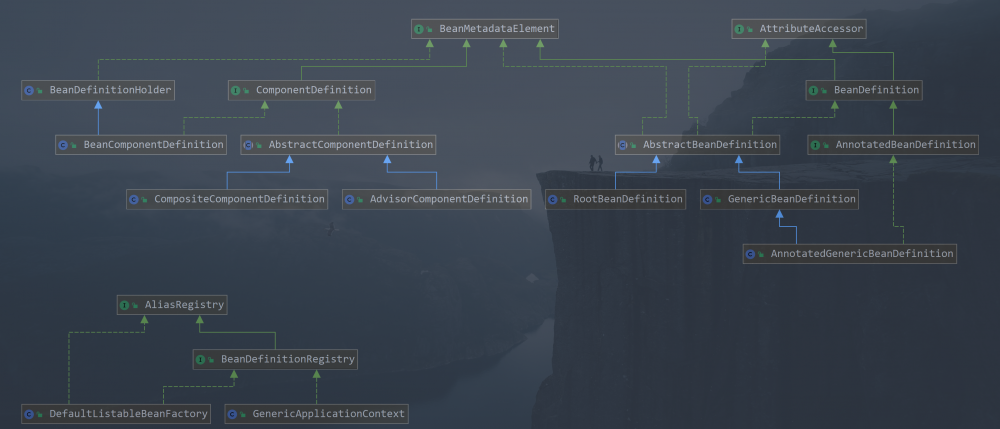深入Spring之IOC之加载BeanDefinition

本文主要分析 spring 中 BeanDefinition 的加载,对于其解析我们在后面的文章中专门分析。
BeanDefinition 是属于 Spring Bean 模块的,它是对 spring bean 的统一抽象描述定义接口,我们知道在spring中定义bean的方式有很多种,如XML、注解以及自定义标签,同事Bean的类型也有很多种,如常见的工厂Bean、自定义对象、Advisor等等,我们在分析加载BeanDefinition之前,首先来了解它的定义和注册设计。

上面类图我们做一个简单介绍,具体详细介绍在后面的相关文章说明
-
AliasRegistry为 Bean注册一个别名的顶级接口 -
BeanDefinitionRegistry主要用来把bean的描述信息注册到容器中,spring在注册bean时一般是获取到bean后通过BeanDefinitionRegistry来注册当当前的BeanFactory中 -
BeanDefinition是用来定义描述 Bean的名字、作用域、角色、依赖、懒加载等基础信息,以及包含与spring容器运行和管理Bean信息相关的属性。spring中通过它实现了对bean的定制化统一,这也是一个核心接口层 -
AnnotatedBeanDefinition是一个接口,继承了BeanDefinition, 对其做了一定的扩展,主要用来描述注解Bean的定义信息 -
AttributeAccessor主要用来设置 Bean配置信息中的属性和属性值的接口,实现key-value的映射关系 -
AbstractBeanDefinition是对BeanDefintion的一个抽象化实现,是一个模板,具体的详细实现交给子类
2. BeanDefinition
ClassPathResource resource = new ClassPathResource("bean.xml"); // <1>
DefaultListableBeanFactory factory = new DefaultListableBeanFactory(); // <2>
XmlBeanDefinitionReader reader = new XmlBeanDefinitionReader(factory); // <3>
reader.loadBeanDefinitions(resource);
上面这段代码是 spring 中从资源的定位到加载过程,我们可以简单分析一下:
- 通过
ClassPathResource进行资源的定位,获取到资源 - 获取
BeanFactory,即上下文 - 通过工厂创建一个特定的
XmlBeanDefinitionReader对象,该Reader是一个资源解析器, 实现了BeanDefinitionReader接口 - 装载资源
整个过程分为三个大步骤,示意图:

我们文章主要分析的就是第二步,装载的过程,
3.loadBeanDefinitions
资源的定位我们之前文章分析过了,不在阐述,这里我们关心 reader.loadBeanDefinitions(resource); 这句的具体实现,
通过代码追踪我们可以知道方法 #loadBeanDefinitions(...) 是定义在 BeanDefinitionReader 中的,而他的具体实现是在 XmlBeanDefinitionReader 类中,代码如下:
/**
* 从指定的xml文件中加载bean的定义
* Load bean definitions from the specified XML file.
* @param resource the resource descriptor for the XML file
* @return the number of bean definitions found
* @throws BeanDefinitionStoreException in case of loading or parsing errors
*/
@Override
public int loadBeanDefinitions(Resource resource) throws BeanDefinitionStoreException {
//调用私有方法处理 这里将resource进行了编码处理,保证了解析的正确性
return loadBeanDefinitions(new EncodedResource(resource));
}
/**
* 装载bean定义的真实处理方法
* Load bean definitions from the specified XML file.
* @param encodedResource the resource descriptor for the XML file,
* allowing to specify an encoding to use for parsing the file
* @return the number of bean definitions found
* @throws BeanDefinitionStoreException in case of loading or parsing errors
*/
public int loadBeanDefinitions(EncodedResource encodedResource) throws BeanDefinitionStoreException {
//1.对资源判空
Assert.notNull(encodedResource, "EncodedResource must not be null");
if (logger.isTraceEnabled()) {
logger.trace("Loading XML bean definitions from " + encodedResource);
}
//2.获取当前线程中的 EncodedResource 集合 -> 已经加载过的资源
Set<EncodedResource> currentResources = this.resourcesCurrentlyBeingLoaded.get();
//3.若当前已加载资源为空,则创建并添加
if (currentResources == null) {
currentResources = new HashSet<>(4);
this.resourcesCurrentlyBeingLoaded.set(currentResources);
}
//4.添加资源到集合如果已加载资源中存在 则抛出异常
if (!currentResources.add(encodedResource)) {
throw new BeanDefinitionStoreException(
"Detected cyclic loading of " + encodedResource + " - check your import definitions!");
}
//5.获取 encodedResource 中的 Resource ,在获取 intputSteram 对象
try (InputStream inputStream = encodedResource.getResource().getInputStream()) {
InputSource inputSource = new InputSource(inputStream);
if (encodedResource.getEncoding() != null) {
inputSource.setEncoding(encodedResource.getEncoding());
}
//6. 真实执行加载beanDefinition业务逻辑的方法
return doLoadBeanDefinitions(inputSource, encodedResource.getResource());
}
catch (IOException ex) {
throw new BeanDefinitionStoreException(
"IOException parsing XML document from " + encodedResource.getResource(), ex);
}
finally {
//7.从已加载集合中去除资源
currentResources.remove(encodedResource);
if (currentResources.isEmpty()) {
this.resourcesCurrentlyBeingLoaded.remove();
}
}
}
-
通过
resourcesCurrentlyBeingLoaded.get()代码,来获取已经加载过的资源,然后将encodedResource加入其中,如果resourcesCurrentlyBeingLoaded中已经存在该资源,则抛出BeanDefinitionStoreException异常。 -
为什么需要这么做呢?答案在 "Detected cyclic loading" ,避免一个
EncodedResource在加载时,还没加载完成,又加载自身,从而导致死循环。也因此,,当一个EncodedResource加载完成后,需要从缓存中剔除。 -
从
encodedResource获取封装的Resource资源,并从Resource中获取相应的InputStream,然后将InputStream封装为InputSource,最后调用#doLoadBeanDefinitions(InputSource inputSource, Resource resource)方法,执行加载BeanDefinition的真正逻辑
protected int doLoadBeanDefinitions(InputSource inputSource, Resource resource)
throws BeanDefinitionStoreException {
try {
//1. 获取到 Document 实例
Document doc = doLoadDocument(inputSource, resource);
//2. 注册bean实列,通过document
int count = registerBeanDefinitions(doc, resource);
if (logger.isDebugEnabled()) {
logger.debug("Loaded " + count + " bean definitions from " + resource);
}
return count;
}
catch (BeanDefinitionStoreException ex) {
throw ex;
}
catch (SAXParseException ex) {
throw new XmlBeanDefinitionStoreException(resource.getDescription(),
"Line " + ex.getLineNumber() + " in XML document from " + resource + " is invalid", ex);
}
catch (SAXException ex) {
throw new XmlBeanDefinitionStoreException(resource.getDescription(),
"XML document from " + resource + " is invalid", ex);
}
catch (ParserConfigurationException ex) {
throw new BeanDefinitionStoreException(resource.getDescription(),
"Parser configuration exception parsing XML from " + resource, ex);
}
catch (IOException ex) {
throw new BeanDefinitionStoreException(resource.getDescription(),
"IOException parsing XML document from " + resource, ex);
}
catch (Throwable ex) {
throw new BeanDefinitionStoreException(resource.getDescription(),
"Unexpected exception parsing XML document from " + resource, ex);
}
}
上面 #registerBeanDefinitions(...) 方法是 beanDefinition 的具体加载过程, #doLoadDocument(...) 是解析 document 的方法内部包含 spring 的验证模型与 document 解析两块,这些我们在后面专门进行分析
本文由AnonyStar 发布,可转载但需声明原文出处。
仰慕「优雅编码的艺术」 坚信熟能生巧,努力改变人生
欢迎关注微信公账号 :云栖简码 获取更多优质文章
更多文章关注笔者博客 : 云栖简码











![[HBLOG]公众号](https://www.liuhaihua.cn/img/qrcode_gzh.jpg)

